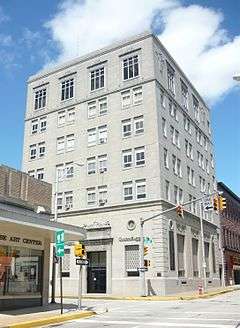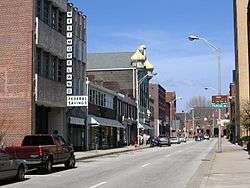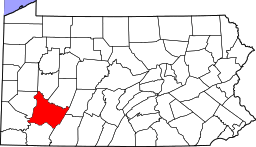Latrobe, Pennsylvania
| Latrobe, Pennsylvania | |
|---|---|
| City | |
|
Looking down Main Street | |
 Latrobe | |
| Coordinates: 40°18′54″N 79°22′52″W / 40.31500°N 79.38111°W | |
| Country | United States |
| State | Pennsylvania |
| County | Westmoreland |
| Settled | 1852 |
| Incorporated (borough) | May 24, 1854 |
| Incorporated (city) | 1999 |
| Government | |
| • Type | City Council |
| • Mayor | Rosemarie M. Wolford |
| Area | |
| • Total | 2.3 sq mi (6 km2) |
| Elevation | 997 ft (304 m) |
| Population (2010) | |
| • Total | 8,338 |
| • Density | 3,625.2/sq mi (1,399.7/km2) |
| Time zone | Eastern (EST) (UTC-5) |
| • Summer (DST) | EDT (UTC-4) |
| ZIP code | 15650 |
| Area code(s) | 724 |
| Website | http://www.cityoflatrobe.com |
Latrobe /leɪˈtroʊb/ is a city in Westmoreland County, Pennsylvania in the United States and part of the Pittsburgh metropolitan area.
The city population was 8,338 as of the 2010 census (9,265 in 1990). It is located near Pennsylvania's scenic Chestnut Ridge. Latrobe was incorporated as a borough in 1854, and as a city in 1999. The current Mayor is Rosemarie M. Wolford.
Among its claims to fame, Latrobe is the home of Saint Vincent Archabbey , the Latrobe Brewery (the original brewer of Rolling Rock beer), Saint Vincent College and golfer Arnold Palmer. It was the childhood home of Fred Rogers, children's television personality who was buried there in Unity Cemetery after his death in 2003. In addition, it is the birthplace of trumpeter Dennis Ferry. While it was believed for years that the first professional football game was played in Latrobe, the city's claim was refused induction into the Hall of Fame records.[1] Latrobe is home of the first banana split, invented in Latrobe by David Strickler in 1904.[2] Latrobe is also home to the training camp of the six time Super Bowl champion Pittsburgh Steelers.
In May 2006, Anheuser-Busch purchased the Rolling Rock brands, but not the brewery. In June 2006, City Brewing Company from La Crosse, Wisconsin entered into negotiations to buy the brewery.[3] In September 2006, City Brewing Company agreed to purchase the brewery,[4] and they licensed it to the Boston Beer Company in April 2007 as a satellite brewery to produce Samuel Adams beers.[5] Sam Adams production did not last long. The plant is currently brewing Iron City Beer under contract. In addition, Duquesne Bottling Company has brewed the revived Duquesne Beer, "The Prince of Pilseners", at the Latrobe plant.
History
In 1852, Oliver Barnes (a civil engineer for the Pennsylvania Railroad) laid out the plans for the community that was incorporated in 1854 as the Borough of Latrobe. Barnes named the town for his best friend and college classmate, Benjamin Latrobe, who was a civil engineer for the B&O Railroad. (His father, Benjamin Henry Latrobe, was the architect who rebuilt the United States Capitol in Washington, D.C. after the War of 1812.)
Its location along the route of the Pennsylvania Railroad helped Latrobe develop into a significant industrial hub. Latrobe was also served by the Ligonier Valley Railroad from 1877 to 1952.
In 1904, the banana split was invented in Latrobe by David Evans Strickler at Strickler's Drug Store.[2]
Two interurban (long-distance trolley) lines served Latrobe: The Westmoreland County Railway Company connected Latrobe to Derry, operating 1904 to 1932.[6] Also, Latrobe Street Railway Company began operations in 1900, connecting Latrobe to Kingston.[7] That line was purchased by West Penn Railways, which eventually linked it with its network running through Youngstown, Pleasant Unity, and eventually to Greensburg and Uniontown. Service ceased in 1952.[7]
Latrobe has two sites on the National Register of Historic Places within its city boundaries:
- Pennsylvania Railroad Station at Latrobe (325 McKinley Avenue): This station was built by the Pennsylvania Railroad in 1903.[8]
- Citizens National Bank of Latrobe (816 Ligonier Street): At six stories, this is the city’s tallest building, previously known as the Mellon Bank Building. This 1926 structure was designed by the Greensburg firm of Batholomew & Smith.[9]
Early professional football team

From 1895 until 1909, Latrobe was the home of the Latrobe Athletic Association, one of the earliest professional football teams. The team's quarterback, John Brallier, became the first football player to admit playing for money. In 1895 he accepted $10 and expenses to play for Latrobe in a 12-0 victory over the Jeannette Athletic Club. Brallier was thought to be the very first professional football player, until the 1960s. It was then, that documents surfaced showing that William "Pudge" Heffelfinger, a former three-time All-American from Yale, was employed to play guard for the Allegheny Athletic Association three years earlier.[10] In 1897, Latrobe was the first football team to play a full season with a team composed entirely of professional players. In 1898 Latrobe and two players from their rivals, the Greensburg Athletic Association, formed the very first professional football all-star team for a game against the Duquesne Country and Athletic Club, to be played at Pittsburgh's Exposition Park. Duquesne went on to win the game 16-0.[11] On November 18, 1905, Latrobe defeated the Canton Bulldogs, which later became a founding member, and two-time champion, of the National Football League, 6-0.[12]
Aside from Brallier, the Latrobe Athletic Association included several of the era's top players, such as: Ed Abbaticchio, Charles Barney, Alf Bull, Jack Gass, Walter Okeson, Harry Ryan, Doggie Trenchard, Eddie Wood and manager Dave Berry.
Geography
Latrobe is located at 40°18′54″N 79°22′52″W / 40.31500°N 79.38111°W (40.314940, -79.381171).[13] According to the United States Census Bureau, the city has a total area of 2.3 square miles (6.0 km2), all land.
Demographics

| Historical population | |||
|---|---|---|---|
| Census | Pop. | %± | |
| 1860 | 758 | — | |
| 1870 | 1,127 | 48.7% | |
| 1880 | 1,815 | 61.0% | |
| 1890 | 3,589 | 97.7% | |
| 1900 | 4,614 | 28.6% | |
| 1910 | 8,777 | 90.2% | |
| 1920 | 9,484 | 8.1% | |
| 1930 | 10,644 | 12.2% | |
| 1940 | 11,111 | 4.4% | |
| 1950 | 11,811 | 6.3% | |
| 1960 | 11,932 | 1.0% | |
| 1970 | 11,749 | −1.5% | |
| 1980 | 10,799 | −8.1% | |
| 1990 | 9,265 | −14.2% | |
| 2000 | 8,944 | −3.5% | |
| 2010 | 8,338 | −6.8% | |
| Est. 2015 | 8,081 | [14] | −3.1% |
| [15][16][17][18] | |||
As of the census[17] of 2010, there were 8,338 people, 3,786 households, and 2,458 families residing in the city. The population density was 3,913.6 people per square mile (1,509.8/km²). There were 4,258 housing units at an average density of 1,852.8 per square mile (714.8/km²). The racial makeup of the city was 98.78% White, 0.32% African American, 0.08% Native American, 0.44% Asian, 0.07% from other races, and 0.31% from two or more races. Hispanic or Latino of any race were 0.37% of the population.
There were 3,786 households out of which 26.0% had children under the age of 18 living with them, 48.1% were married couples living together, 11.0% had a female householder with no husband present, and 38.0% were non-families. 34.1% of all households were made up of individuals and 17.9% had someone living alone who was 65 years of age or older. The average household size was 2.22 and the average family size was 2.86.
In the city the population was spread out with 1,730 persons under the age of 18, 429 persons from 20 to 24, 2583 persons from 25 to 49, 1780 persons from 50 to 64, and 1614 persons who were 65 years of age or older. The median age was 42 years. For every 100 females there were 88.0 males. For every 100 females age 18 and over, there were 83.2 males.
The median income for a household in the city was $33,268, and the median income for a family was $42,168. Males had a median income of $31,802 versus $22,227 for females. The per capita income for the city was $18,208. About 6.5% of families and 9.4% of the population were below the poverty line, including 9.2% of those under age 18 and 7.6% of those age 65 or over.
Federally, Latrobe is part of Pennsylvania's 18th congressional district.

National Register of Historic Places
Transportation
- Arnold Palmer Regional Airport (formerly known as Westmoreland County Airport)
- Latrobe (Amtrak station)
- Westmoreland Transit Daily runs locally and commuter runs to Pittsburgh & Johnstown.
Notable people
- Arnold Palmer, professional golfer
- Joe Page, major league pitcher
- Fred Rogers, host of the PBS series Mister Rogers' Neighborhood
- Daniel Lentz, classical composer
- Gregory S. Forbes, meteorologist and Severe Weather Expert for The Weather Channel
- Chris Lightcap, jazz bassist
- Boniface Wimmer, Benedictine monk, founded Saint Vincent Archabbey in 1845
In popular culture
- Latrobe is featured in "Scan", an episode of the television series Prison Break. Fugitive Fernando Sucre is stopped by a Pennsylvania State Trooper, but runs through a field and presumably jumps aboard a cargo train headed towards New York.
- Latrobe is featured prominently in the 2008 feature length Kurt Kuenne documentary entitled Dear Zachary: A Letter to a Son About His Father. The basis of the movie is the murder of local doctor Andrew Bagby by his former partner.[19]
- In George Romero's Night of the Living Dead the town is featured as a sanctuary from the uprising of the dead.
- Latrobe Brewing Company is on a sign in the background of a bar in the film Gone Girl.
- Latrobe is mentioned on an episode of Quantum Leap as the setting of character Arnold Watkins' (Tristan Tait) parents' final resting place.
See also

National Register of Historic Places
- Arnold Palmer Regional Airport
- Fred Rogers
- Greater Latrobe School District
- Kennametal
- Latrobe Athletic Association
- Latrobe Country Club
- Loyalhanna Creek
- Pittsburgh Metropolitan Area
- WCNS
- Saint Vincent Archabbey
- Saint Vincent College
- Saint Vincent Seminary
- WAOB Catholic Radio
References
- ↑ "After the Pro Football Hall of Fame was opened in 1963 in Canton, further research uncovered the Pudge Heffelfinger payment by the Allegheny Athletic Association in 1892 and thus negated the Latrobe claim as the birthplace of pro football." Pro Football Hall Of Fame. History. November 12: The Birth of Pro Football. link:http://www.profootballhof.com/history/general/birth.aspx
- 1 2 Turback, Michael (March 2004). The Banana Split Book. Camino Books. ISBN 0-940159-83-X
- ↑ Boselovic, Len (June 22, 2006). "Wisconsin brewer may buy Rolling Rock plant". Pittsburgh Post-Gazette. Retrieved June 25, 2006.
- ↑ City Brewery buys Latrobe Brewery - Pittsburgh Business Times
- ↑ Boselovic, Len (April 4, 2007). "Samuel Adams comes calling on Latrobe brewer". Pittsburgh Post-Gazette.
- ↑ Muller, Edward K.; Ronald C. Carlisle; Christine Davis; Carmen DiCiccio; Gary Fitzsimons; Kenneth D. Rose (1994). Westmoreland County, Pennsylvania: An Inventory of Historic Engineering and Industrial Sites. Washington, DC: America's Industrial Heritage Project, National Park Service. pp. 331–332.
- 1 2 (No author shown) (1973). West Penn Railways. Pittsburgh, Pennsylvania: Pennsylvania Railway Museum Association, Inc. pp. 1and 18.
- ↑ "National Register of Historical Places - Pennsylvania Railroad Station at Latrobe" (PDF). ARCH: Pennsylvania's Historic Architecture & Archeology. Pennsylvania Museum and Historical Commission. Retrieved 2008-09-15.
- ↑ "National Historic Landmarks & National Register of Historic Places in Pennsylvania" (Searchable database). CRGIS: Cultural Resources Geographic Information System. Note: This includes Clinton Piper (May 2002). "National Register of Historic Places Inventory Nomination Form: Citizens National Bank of Latrobe" (PDF). Retrieved 2012-06-10.
- ↑ PFRA Research. "Five Hundred Reasons" (PDF). Coffin Corner. Professional Football Researchers Association: 1–6.
- ↑ PFRA Research. "Stars Over All-Stars" (PDF) (Annual). Professional Football Researchers Association: 1–5.
- ↑
- Van Atta, Robert (1980). "Latrobe, PA: Cradle of Pro Football" (PDF). Coffin Corner. Professional Football Researchers Association. 2 (Annual): 1–21.
- ↑ "US Gazetteer files: 2010, 2000, and 1990". United States Census Bureau. 2011-02-12. Retrieved 2011-04-23.
- ↑ "Annual Estimates of the Resident Population for Incorporated Places: April 1, 2010 to July 1, 2015". Retrieved July 2, 2016.
- ↑ "Number of Inhabitants: Pennsylvania" (PDF). 18th Census of the United States. U.S. Census Bureau. Retrieved 22 November 2013.
- ↑ "Pennsylvania: Population and Housing Unit Counts" (PDF). U.S. Census Bureau. Retrieved 22 November 2013.
- 1 2 "American FactFinder". United States Census Bureau. Retrieved 2008-01-31.
- ↑ "Incorporated Places and Minor Civil Divisions Datasets: Subcounty Population Estimates: April 1, 2010 to July 1, 2012". U.S. Census Bureau. Retrieved 25 November 2013.
- ↑ http://www.post-gazette.com/local/westmoreland/2009/01/08/Film-gives-a-shocking-look-at-killing/stories/200901080306
External links
| Wikimedia Commons has media related to Latrobe, Pennsylvania. |
- City of Latrobe website
- Greater Latrobe Community Network
- The Latrobe Area Historical Society
- Photographs of the Latrobe steel mill
- Saint Vincent Archabbey
- Boniface Wimmer
Coordinates: 40°18′54″N 79°22′52″W / 40.31494°N 79.381171°W

